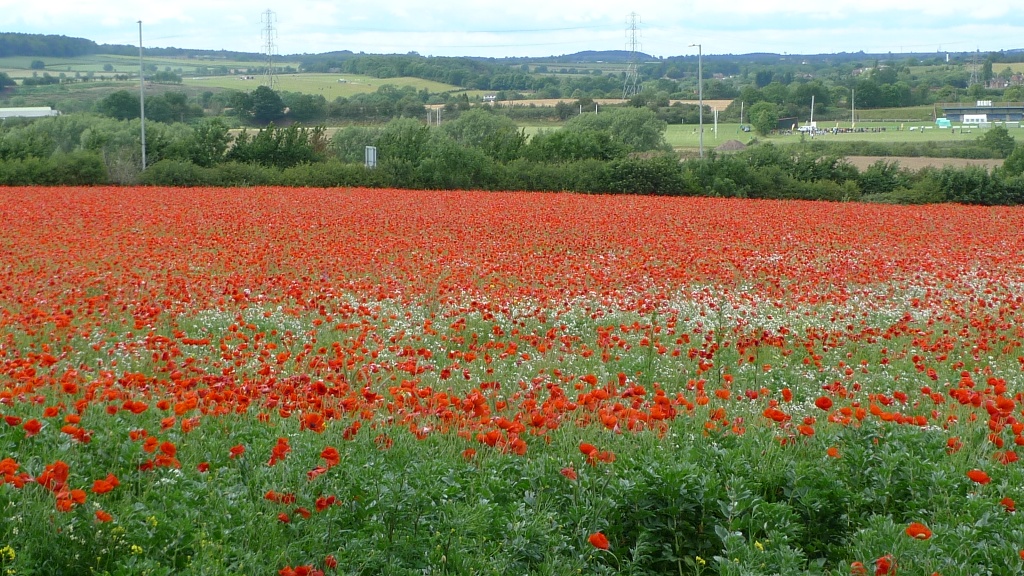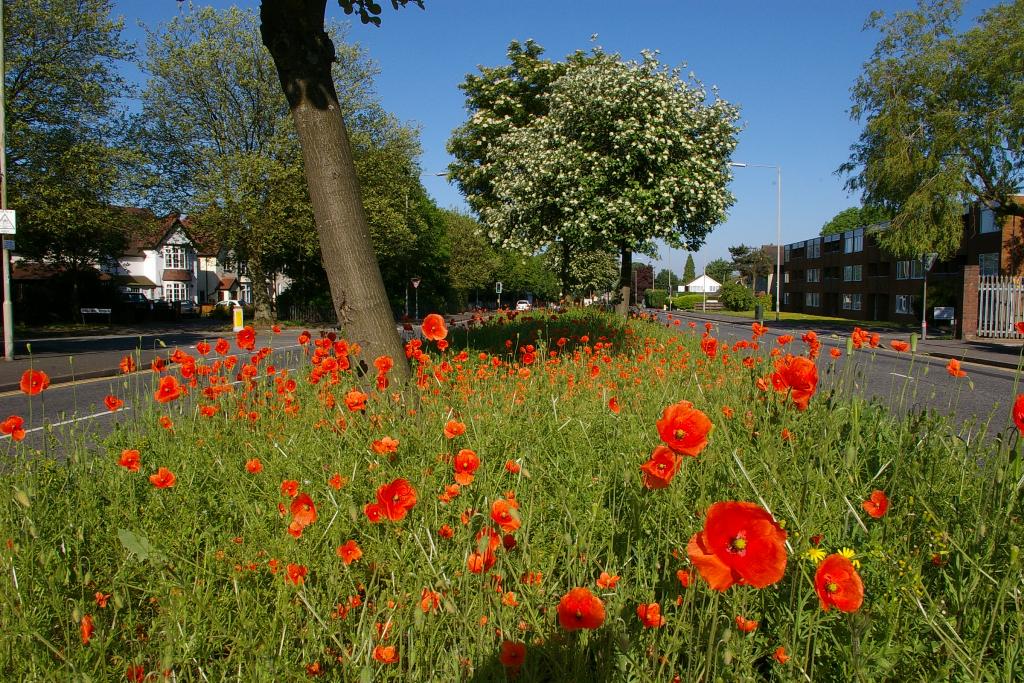
This week I’d like to talk about the Common Poppy or Papaver rhoeas, which is a symbol in Britain for the millions of casualties in the First World War and since.
It belongs to the Papaveraceae or Poppy family which is number 34 in Stace.
This weekend we will have Remembrance Sunday here which is always the nearest Sunday to Armistice * Day (on 11-11). This was signed at 5 am on the 11th November, 1918 to be precise but all the fighting ceased at 11 am, so exactly 100 years ago!
*Armistice means: a Ceasefire or suspension of hostilities or also an agreement made by opposing sites to stop fighting for a certain time or a truce.
Papaver, also ‘pappa’, is the Latin word for food or milk and ‘rhoeas’ means red in Greek.
Contents:
Papaver cambricum or Welsh Poppy
Papaver spp.
* Edible uses: * Medicinal uses: * Other uses:
Papaver somniferum or Opium Poppy
The Poppy family or Papaveraceae has 12 genera and is split into 2 Sub-families; the Papaveroideae with 7 genera and the Fumarioideae with 5 genera. The Papaveroideae has 2 sepals, 4(-6) showy petals, and white or yellow latex. The distinctive flowers of subfamily Fumarioideae are unique, but the two subfamilies are linked by intermediates (Stace).
Papaver cambricum or Welsh Poppy
The Poppy is in the genus Papaver and has actually only one true native, being the Welsh Poppy or Papaver cambricum, which was until recently known as Meconopsis cambricum.
A long-lived perennial herb, native in damp, rocky woodlands and on shaded cliff ledges. It is also grown in gardens and has become naturalised on hedge banks, walls, roadsides and waste ground. Native plants range from the lowlands to 640 m
It has been used since 2006 as the basis for the logo of the political party Plaid Cymru.
Native populations rarely spread into apparently suitable habitat and are probably in slow decline. In contrast, garden plants can spread rapidly and the species is increasing as an established alien. Within its core native areas, it can be difficult to separate native from alien occurrences, particularly in Ireland.
Papaver spp.

All the other Papaver species including Papaver rhoeas and Papaver dubium or Long-headed Poppy are archyophytes. The former Papaver argemone or Prickly Poppy is also now known by the new alternative name of Roemeria argemone, just to be difficult.
The poppy of all the various species is a delicate flower on tall stems and still a rare but beautiful sight in the countryside and disturbed land.
Red flowers are one of our rarer colours in these climates and, therefore, extra special. Their thousands of seeds in each plant (17.000 per plant is estimated!) can lay dormant in the soil for many decennia and then grow and flower en masse when coming to the surface by ploughing or other soil disturbance.
It was one of our common agricultural weeds, but has very efficiently been eradicated from our crops as a nuisance.
Now the poppy is often part of an ornamental, annual cornfield seed-mixture, which can attract many beneficial insects. For example see here:
As well as being the symbol of remembrance and peace, the Common or Red Poppy is symbolically the plant of forgetfulness and sleep. In some cultures it has been a plant of fertility, with its fast production of seeds and vivid red petals, a reminder of the blood of life and of war, as also of renewal and rebirth. (from Hedgerow Medicine)
Some interesting facts and natural history from Wikipedia:
The Poppy is known to have been associated with agriculture in the Old World since early times and has had an old symbolism and association with agricultural fertility. It has most of the characteristics of a successful weed of agriculture. These include an annual life cycle that fits into that of most cereals, a tolerance of simple weed control methods, the ability to flower and seed itself before the crop is harvested, and the ability to form a long-lived seed bank.
The leaves and latex have an acrid taste and are mildly poisonous to grazing animals.
Papaver rhoeas topped the list in a UK study of meadow pollen production. The Californian poppy placed second. The pollen production of Papaver rhoeas, on a per flower basis, was very high in comparison with the other plants tested, at almost triple the amount of the top-ranked perennial (a mallow). When sampled at the level of the entire capitulum, however, Papaver rhoeas was outranked by the ox-eye daisy, Leucanthemum vulgare. It tied with Cosmos bipinnatus. Neither poppy produced a significant quantity of nectar, making their role in meadow ecology specific to pollen-gathering/consuming insects.
As poppies are not wind-pollinated, their pollen poses no allergy risk via inhalation.
Due to the extent of ground disturbance in warfare during World War I, red poppies flowered in between the trench lines and no man’s lands on the Western front. Poppies are a prominent feature of “In Flanders Fields” by Canadian Lieutenant Colonel John McCrae, one of the most frequently quoted English-language poems composed during the First World War. During the 20th century, the wearing of a poppy at and before Remembrance Day (sometimes known informally as Poppy Day) each year became an established custom in Britain. It is also used at some other dates in some countries, such as at appeals for Anzac Day in Australia and New Zealand.
Edible uses:
(most of below information (but much edited) from PFAF website here:
- Seed can be eaten raw or cooked. Much used as a flavouring in cakes, bread, fruit salads etc. It imparts a very nice nutty flavour.
- An edible oil is obtained from the seed. Said to be an excellent substitute for olive oil, it can be used in salad dressings or for cooking.
- A syrup can be prepared from the scarlet flower petals, it is used in soups, gruels etc.
- A red dye from the petals is used as a food flavouring, especially in wine and for herbal remedies, in sweets and herbal teas.
- The petals can be added in summer salads.
Medicinal uses:
Papaver rhoeas contains the alkaloid called rhoeadine which is a mild sedative. It contains no morphine as does its related species, P. somniferum or the Opium Poppy.
The flowers of common poppy have a long history of medicinal usage, especially for ailments in the elderly and children.
- An infusion is taken internally in the treatment of bronchial complaints and coughs, insomnia, poor digestion, nervous digestive disorders and minor painful conditions.
- The flowers are also used in the treatment of jaundice. The petals are harvested as the flowers open and are dried for later use. They should be collected on a dry day and can be dried or made into syrup.
- The latex in the seed pods is narcotic and slightly sedative. It can be used in very small quantities, and under expert supervision, as a sleep-inducing drug.
- The leaves and seeds are tonic. They are useful in the treatment of low fevers.
- The plant has anticancer properties.
Other uses:
- Very useful for insects due to its high pollen count (see information in blue above).
- A red dye is obtained from the flowers, though it is very fugitive.
- A syrup made from the petals has been used as a colouring matter for old inks.
- The red petals are used to add colour to pot-pourri.
- There are several named cultivars suitable as an ornamental plant in annual mixes.
- The seed heads are attractive in dry flower arrangements.
Papaver somniferum or Opium Poppy
Papaver somniferum or Opium Poppy is another archyophytes but also a well known crop and ornamental garden plant for its attractive flowers and seed-heads.
An annual occurring as a casual garden escape on roadsides, waste ground and rubbish tips, and occasionally in arable fields as a relic of cultivation for poppy seed. Lowland, with one record at 410 m
This plant contains a number of very toxic compounds, many of which are extracted and used as pain killers etc in medicine. They are also used to make various highly addictive narcotic drugs!
However, in the cooler climate of Britain these compounds are not formed in sufficient quantity to make their extraction worthwhile. There are no toxins in the seeds.
Young leaves can be used raw or cooked. They must be used before the flower buds have formed. In some countries they are eaten at the seedling stage.
Seeds can be used raw or cooked.
- Much used as a flavouring in cakes, bread, fruit salads etc.
- The crushed and sweetened seeds are used as a filling in crepes, strudels, pastries etc.
- Highly nutritious, the seed contains about 22.7% protein, 48% fat, 9.8% carbohydrate, 7.1% ash. It is also a good source of lecithin.
- A high quality edible drying oil is obtained from the seed. It has an almond flavour and makes a good substitute for olive oil.
Medicinal Uses: Plants For A Future can not take any responsibility for any adverse effects from the use of plants. Always seek advice from a professional before using a plant medicinally.
The opium poppy contains a wide range of alkaloids and has been a very valuable medicine, especially useful in bringing relief from pain.
Its use (especially of the extracted alkaloids opium and morphine which it contains) can become addictive, however, and so it should be treated with extreme caution and only be used under the supervision of a qualified practitioner!
- As well as its pain-relieving properties, the latex has also been used as an antispasmodic and expectorant in treating certain kinds of coughs, whilst its astringent properties make it useful in the treatment of dysentery etc.
- A homeopathic remedy is made from the dried latex. This is used in the treatment of a variety of complaints, including constipation, fevers and insomnia.





